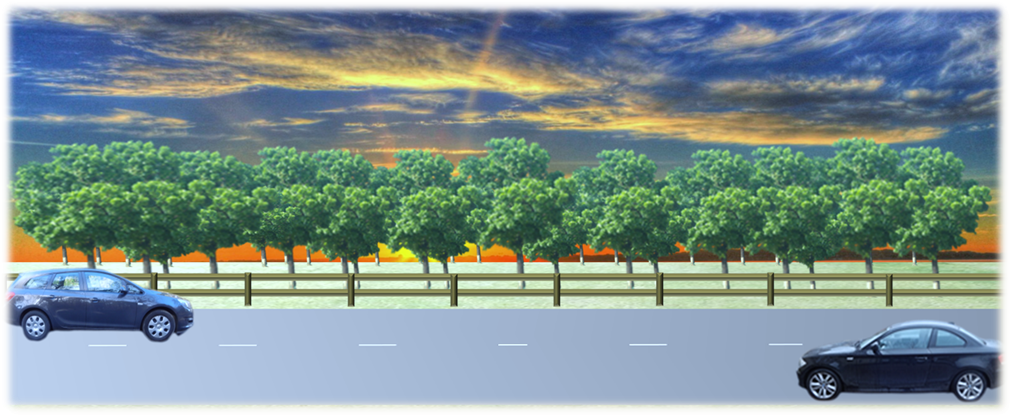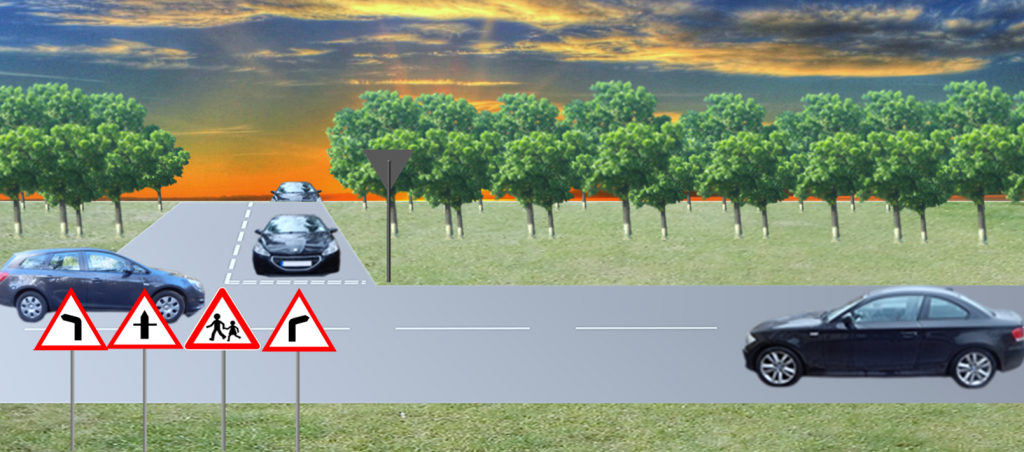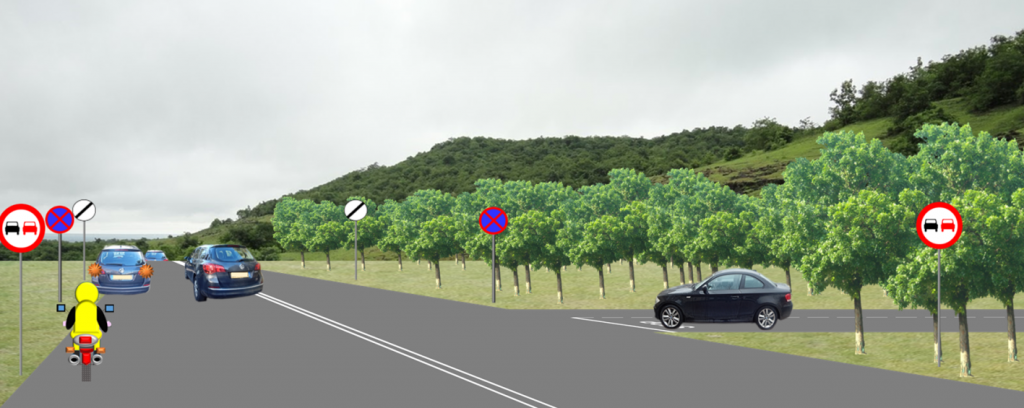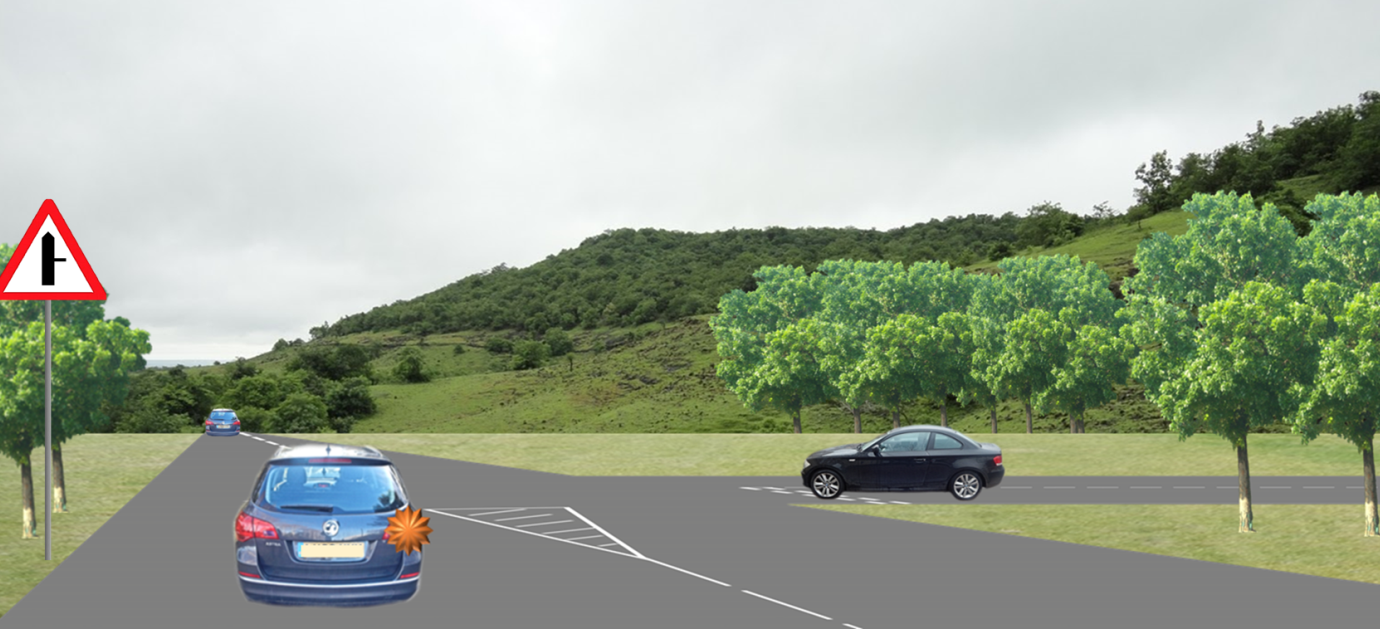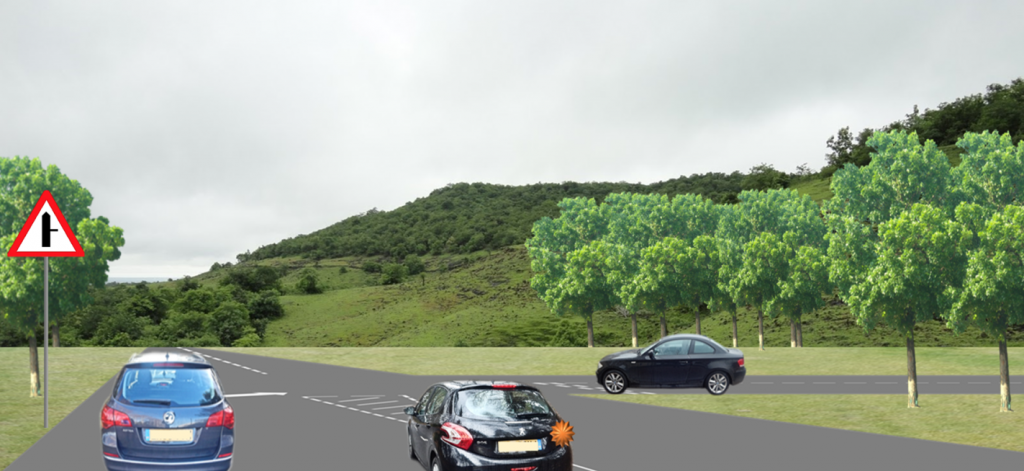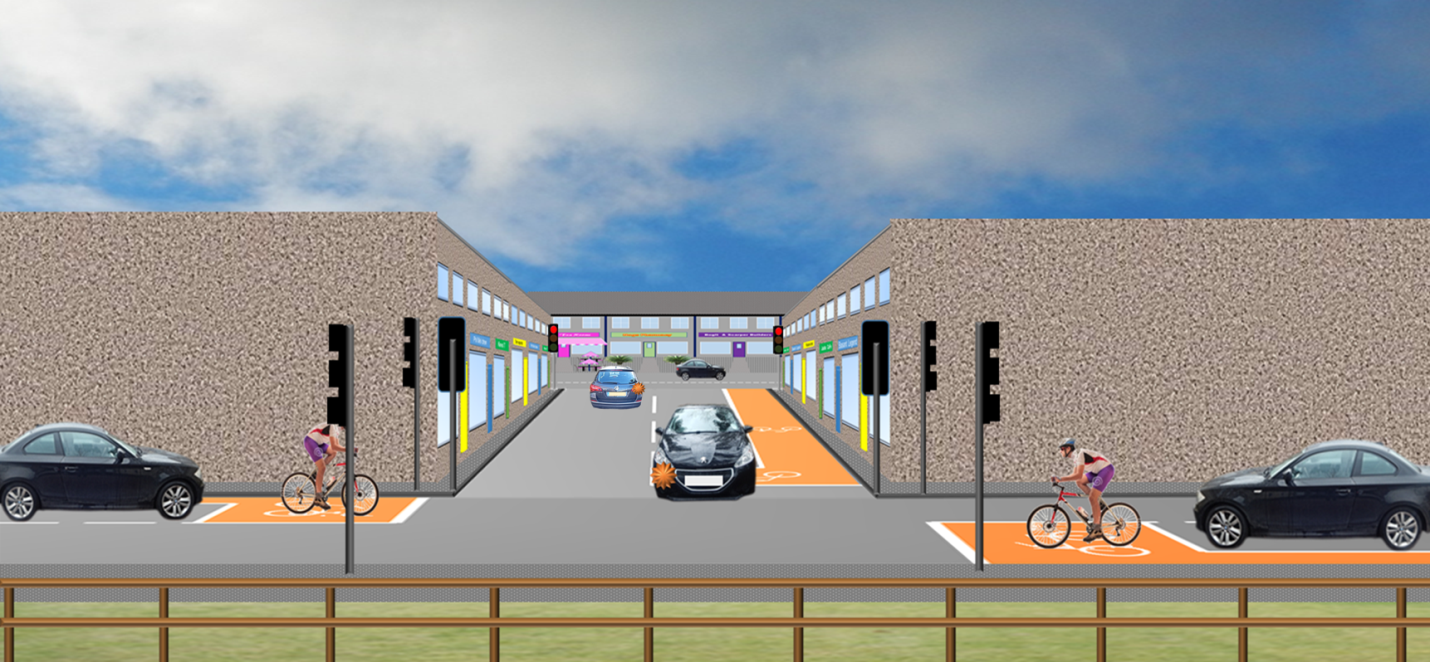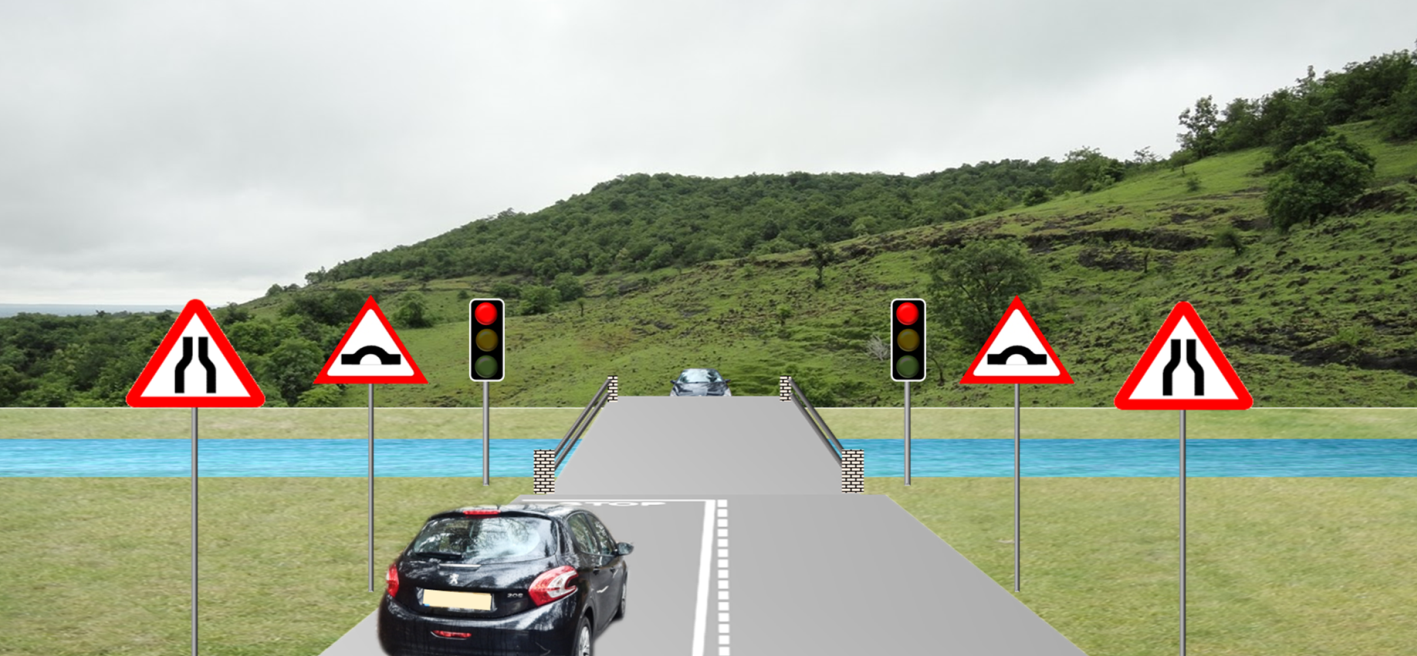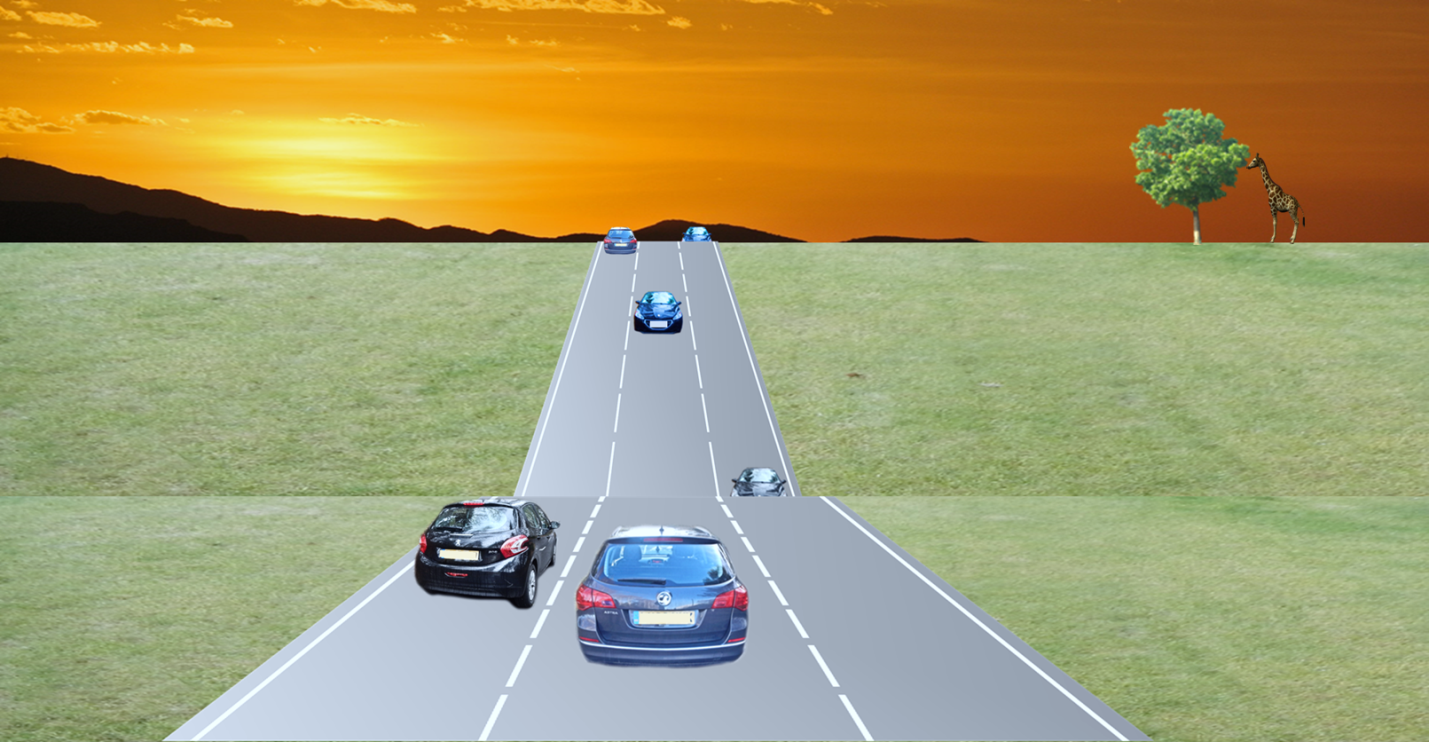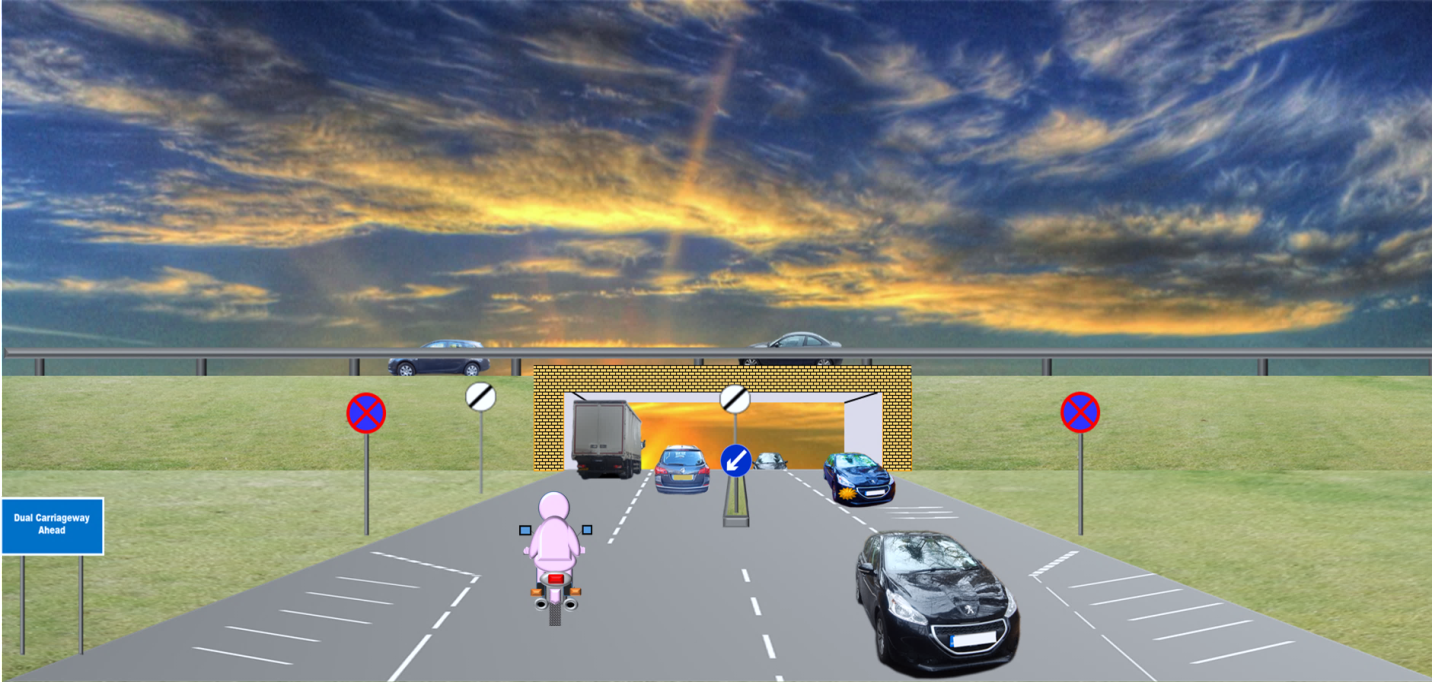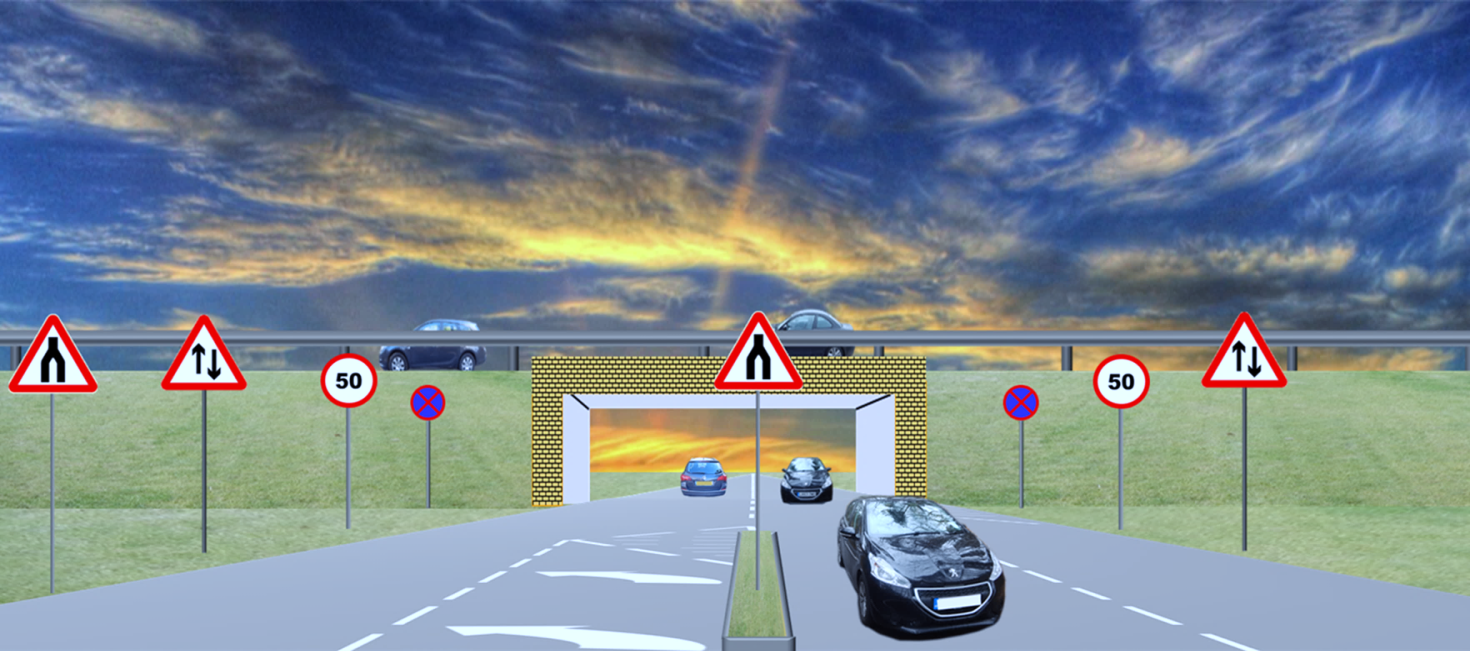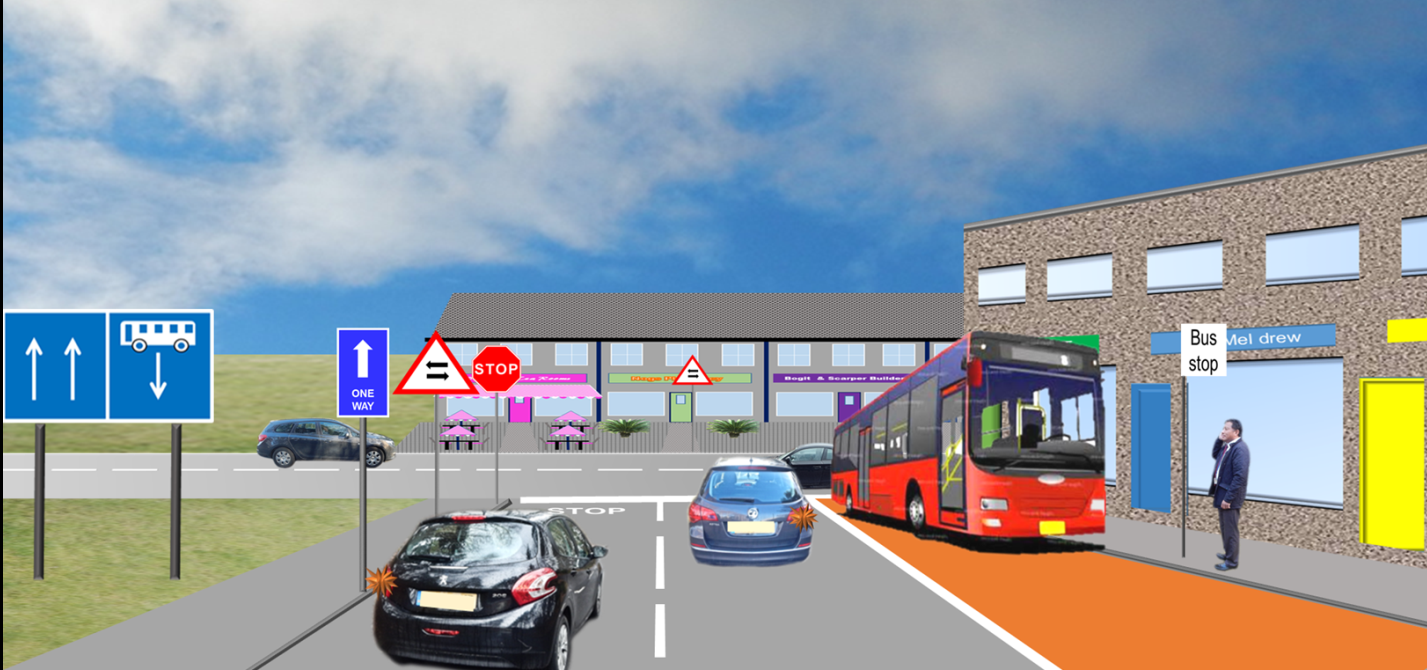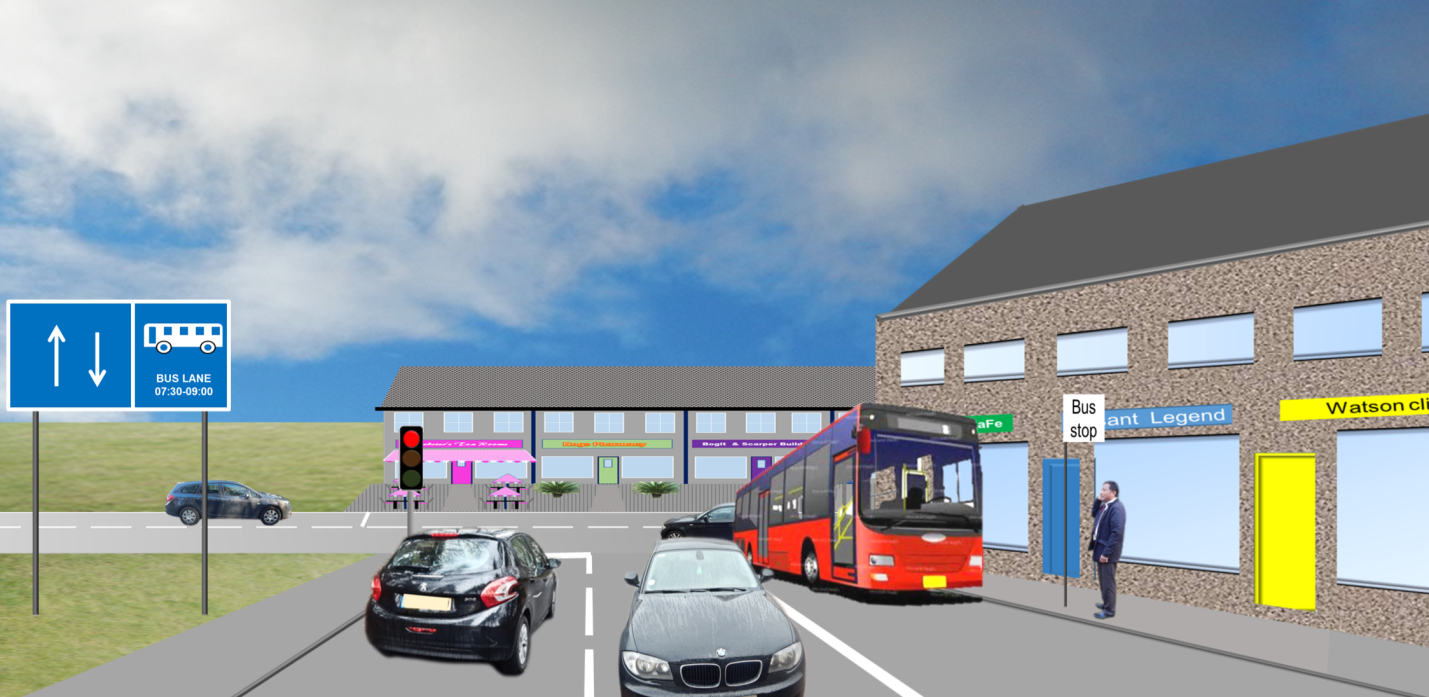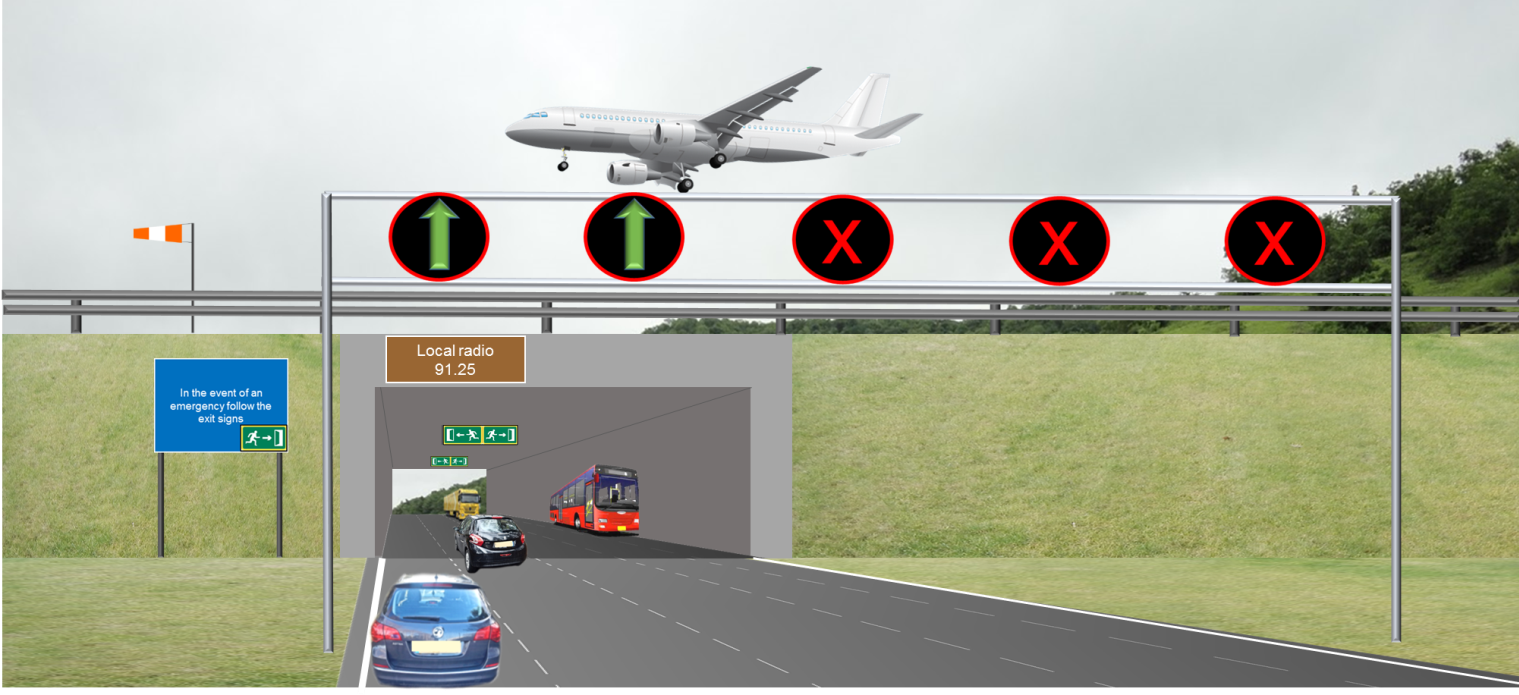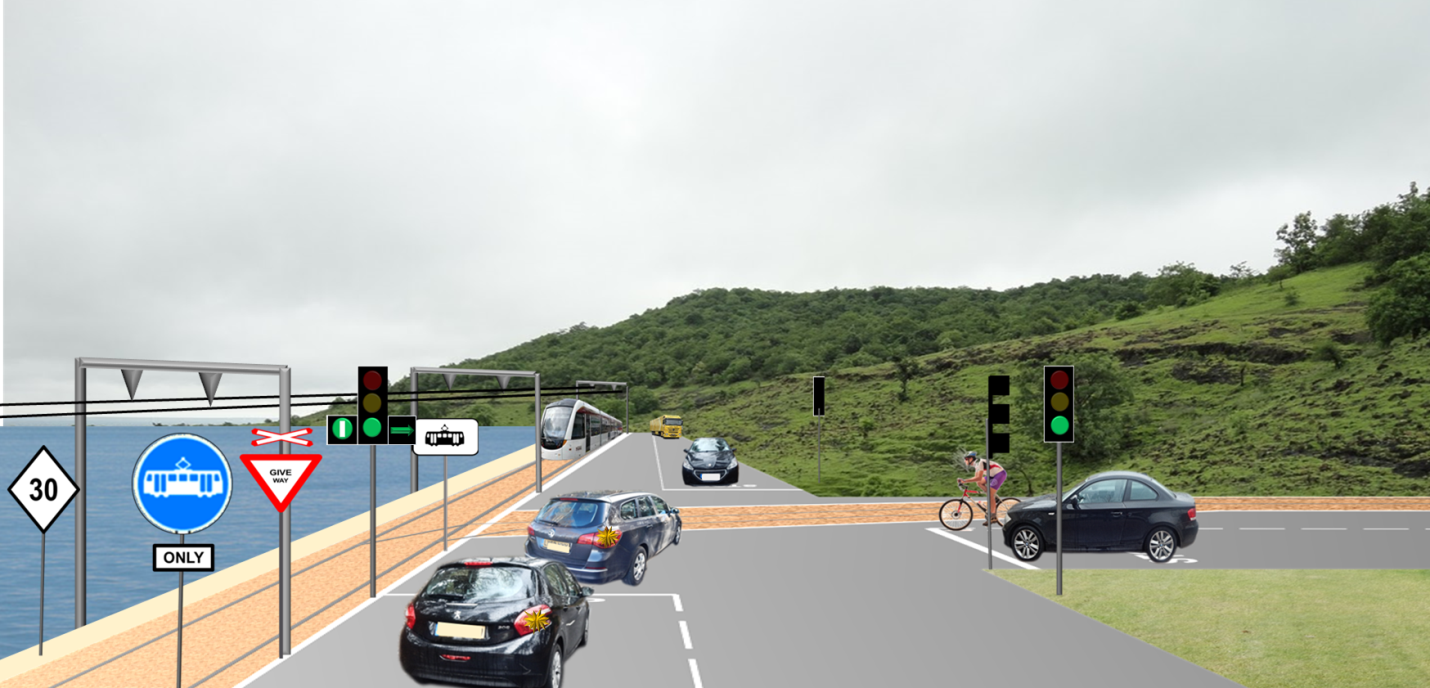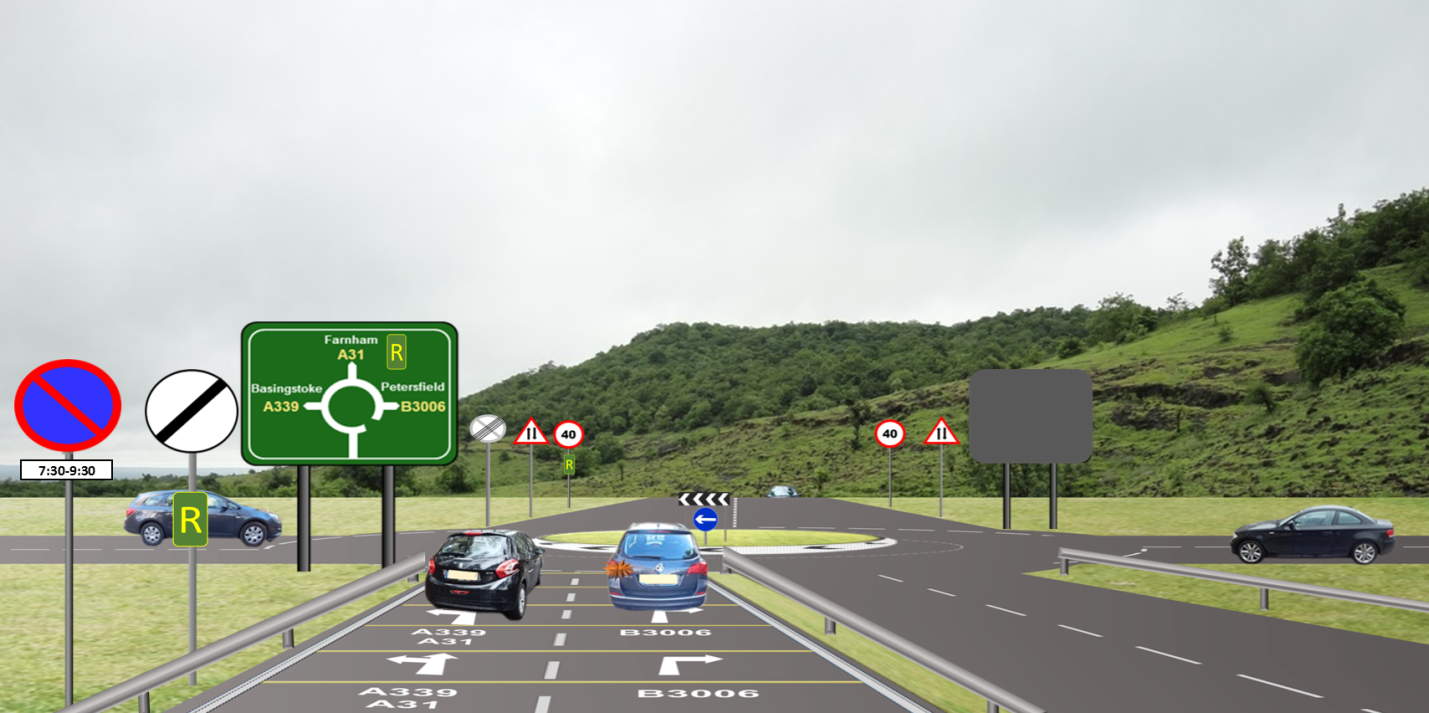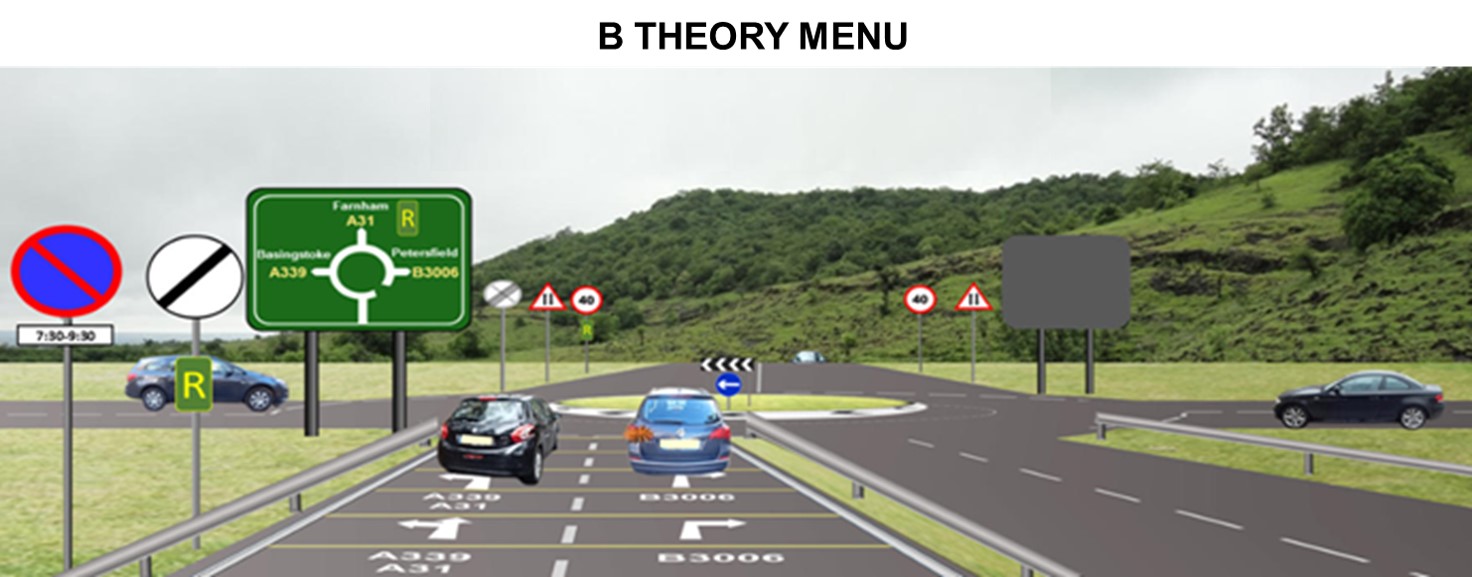ROAD MARKINGS
This section covers road markings and the procedures that must be carried out. Each picture will contain road signs; the signs will be generally positioned where you would normally see them.
The road markings seen in the picture to the left are classed as normal road markings; they are short white lines with a large space between them. The markings tell you there is no imminent danger.
You must always apply common sense and drive safely no matter what road markings you see.
When approaching hazards the lines will change in length and the spaces in between the lines will shorten.
These are classed as hazard markings and, as you can see from the picture, the lines have changed to hazard lines warning you of the junction.
The lines not only draw your attention to the hazard but they will also help you read the road at night in foggy conditions. These markings are not only found at junctions, you will also find them; approaching bends, schools, hidden dips and hills, in fact anywhere where extra caution is required. The relevant warning signs will also be displayed.
As you can see in this picture the centre white lines have changed from broken to solid.
There are only two circumstances that allow you to cross a solid white line. You can only cross them if you are passing a broken-down vehicle or you are overtaking a slow moving vehicle travelling at 10 mph or less. The picture shows a double solid line, the one on the left is yours the one on the right is for oncoming traffic.
The first two traffic signs you approach are mandatory (orders). The first means no overtaking, the second tells you that you are on a clearway so a no stopping or parking rule applies. The white sign with a black diagonal line indicates the national speed limit, on a single carriageway, its 60 mph for a car. The black car is turning right onto the main carriageway. Think about why has it been made into a stop junction.
The lines in the middle of the road are called lane separation lines or hatch markings and are surrounded by a solid white line.
You wish to turn right, but in this situation you must not move into the middle of the road until you have passed the markings, only then can you make the turn. The warning sign is telling you that you are approaching a right turn.
The hatch markings in this picture are surrounded by broken white lines. You are allowed to enter them to allow traffic to pass on your inside. They help keep the traffic flowing. However, try to avoid driving into them if possible.
On rural roads road, markings will change regularly to help inform the driver of any impending hazards. There should also be warning signs to assist you. On this country road there is a lot of information that if driven at a safe speed will help you complete your journey.
The solid white line at the edge of the road is called the edge of road marking; This is in place of a kerb that you would find in more urban areas. There is a possibility that if you cross this line you could find a soft verge which could cause you to lose control of the vehicle.
The markings down the centre of the road are hazard lines, as before they warn you of an impending hazard. In this scenario the hazard is a hidden dip, this is also displayed by the first sign. The sign is warning of a danger. Underneath the sign the danger is displayed in text. The second sign warns of a risk of ice, this is because the road relies on natural drainage and water could gather in the dip and in winter could freeze. As you can see the hidden dip is concealing a vehicle coming towards you. To make this road safer what sort of road markings would you use?
CYCLE LANES
Protecting the environment has caused councils to promote the use of cycles where possible; This reduces the toxic fumes emitted from motor vehicles. This picture shows designated cycle lanes. You as a car driver must avoid driving in them. They are clearly marked with a solid white line and in some circumstances will have a different coloured surface.
At traffic lights you might see advanced stop lines as shown in this picture. Only cycles can stop in this area if the red light is showing. If the cycle lane has a broken white line you may be able to park or stop in them as there might be times of operation.
HUMP BACK BRIDGES
You are approaching this hump back bridge. In the picture it is controlled by traffic lights. The first sign is telling you that the road narrows from both directions. The second sign tells you that you are about to cross a hump back bridge. The road markings tell you that you must not cross the solid white line, but oncoming traffic once clear of the bridge can overtake if safe to do so.
You will also have to cross this type of bridge without traffic control. If you find yourself in this situation extra care must be taken, as you cannot see oncoming traffic. The oncoming driver cannot see you either.
There are still some carriageways that have been divided into three lanes. It is a two-way road but has a middle lane that can be used by traffic in both directions. In the past his has proved dangerous and in some cases fatal.
Many councils have either put hatch markings in the middle lane or have protected lanes with solid white lines. What changes would you make to keep all road users safe?
DUAL CARRIAGEWAYS
On a dual carriageway the correct lane to drive in is the left. The right-hand lane is used for overtaking or turning right. Once you have overtaken a slower moving vehicle you must return to the left-hand lane. In addition to the rules you will also find signs that will help you.
The first sign is blue and tells you that the rules for a dual carriageway have now started. The second sign is a clearway sign, it is mandatory so no stopping or parking is permitted. Because the road is wider and safer to overtake the speed limit has been increased. The national speed limit for a car or motorbike is 70 mph. If you are towing a trailer or caravan the speed limit is 60 mph.
When coming to the end of a dual carriageway the road markings will assist you in taking up the correct position. If you look at the road surface there are white arrows telling you to move to the left-hand lane.
Do not assume everyone will do this in good time as you will get the occasional driver that will try and leave moving back to the last minute.
The first sign warns you of the end of a dual carriageway, the second sign warns and also reminds you that you are now entering a two-way road. There is a change in speed limits indicated by the mandatory 50 mph sign. The blue sign with the red cross enforces that the road is still a clearway so no stopping or parking.
BUS LANES
You find yourself driving down a one-way road. Looking to your right you see a bus driving in the opposite direction. The lane marking between you and the bus is a solid white line.
This bus lane is classed as a contraflow, and must not be used by normal traffic. It is designed to reduce traffic in towns making it easy for people to use public transport and journeys less times consuming.
This road layout is different to the previous picture. The bus lane is a with flow bus lane. Irrespective of the solid line, if it is outside of the times of operation the traffic coming towards you can use both lanes.
If there are no timings it is in operation 24 hours a day, seven days a week and you will not be allowed to drive in it.
TIDAL FLOW SYSTEM
The tidal flow system is designed to help traffic flow during peak traffic times. You must look at the overhead gantry signs to see which lanes you can use. this will change throughout the day.
Before entering the tunnel, tune your radio to the station displayed. This will keep you up to date with any problems that might be in the tunnel. If you break down follow the exit signs located in the tunnel.
TRAM ROUTES
Understanding the road markings is very important. If you find yourself on a tram lane you could be involved in a collision as trams cannot turn to avoid you. The tram lane is protected by a solid white line and the lanes have a different coloured surface. The cyclist on the right must be careful when crossing the junction as the tram rails are metal and the cyclists’ wheels could get caught in the tracks.
The diamond shaped sign is the tram speed limit. The blue circular instructional sign means tram route only. The give way sign with the barrier above means give way to trams. The green light on the left of the lights with the white line means trams can go. The white sign with a picture of a tram means tram route ahead.
ADDITIONAL LANE MARKINGS
You are approaching a roundabout at the end of a dual carriageway, you wish to turn left but you are in the right-hand lane. You have made a mistake and have not seen the early direction markers painted on the road surface. There is a car on your left what should you do?
The lane that you are in tells you that it is a turn right only lane. You must cancel your signal and in this case go around the roundabout. In other situations you would follow the road ahead and find a safe place to turn around.
The lines painted across the road are called rumble strips. They are designed to make you aware of your speed. The speed limit on this road is 70 mph, the first sign is a waiting restriction sign. You can drop off and pick up passengers outside of the times shown.
The green sign with the yellow R is telling you that you are on a ring road. If you were to follow all roads with this sign you would complete a circle and end up back here.
The first sign at the other side of the roundabout tells you that the waiting restrictions have ended.
The warning sign tells you that you are now on a two-way road.
The new speed limit has ended the national speed limit. You must not exceed 40 mph.



